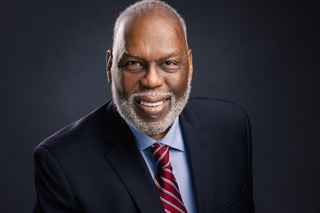Because he has received guidance in his leadership development from many coaches and mentors over the years, I am passionate about “paying it forward” as a coach to others.
“As a youth, I felt a call to build bridges between people across our differences and to cultivate a culture of serving the common good,” says Warner. “That sense of calling drew me to work through the church which eventually led to ordained ministry. Over the years, I have served the church as a Pastor, District Superintendent, Director of Connectional Ministries and Bishop. From 2014-2016, Bishop Brown served as President of the Council of Bishops for the 12 million members, worldwide, of the United Methodist Church.”
He has also been recruited to serve as Interim Lead Pastor for two large multi-staff congregations with challenging leadership transitions. Currently, he is the Interim Bishop for the United Methodist Church in Sierra Leone, West Africa.
Warner’s focus for the next decade is to work with Senior Leaders and Teams of spiritually rooted organisations to confidently develop their current and emerging leaders so that they can achieve their mission and be fulfilled in their life and work.
As a member of the ICF and EMCC Global, Warner stays informed with the latest insights in the profession and continues to develop his expertise in line with the highest coaching standards.
What are the most common barriers limiting leaders from reaching their full potential?
At the heart of leadership is two dynamics – impact and responsibility. The most common barriers to full potential are failure to recognise the impact of behaviour and take responsibility for the actions we take or fail to take.
Impact is the effect that we have on others – our families, communities, the environment and the world. We are constantly impacting others whether we realise it or not, just as when a pebble is dropped into a peaceful pool of water. When people are striving toward empowering others and creating win-win scenarios that still accomplish the desired goal, they are engaging in positive leadership. When people are only trying to achieve their own objectives, they are engaging in negative or destructive leadership.
Responsibility is a leader’s willingness to notice the impact they have and to respond in a way that is conscientious and appropriate. Even though everyone is responsible for their impact, not everyone takes responsibility for it. People commonly deny responsibility by blaming others. It is much easier to deny or blame than it is to take responsibility. But in the long run, blaming others is more difficult than taking responsibility. Because when you blame others, you give up your control. A good leader makes conscientious and appropriate responses to the world around them; they do not deny mistakes – or blame others.
Tell us about the value of team leadership coaching.
Team leadership coaching is an incredibly powerful process that can unlock a team’s aspirations and release energy for activating higher levels of performance.
Many years of working as a leader and experiencing traditional coaching set my expectations towards a model of coaching that was focused on the leader. I saw the work of a leadership coach or team coach as helping the designated leader lead the team.
While working with individual leaders to develop their skills and mindset continues to be a valuable coaching focus, I have come to see the greater impact and long-term benefits of a systematic approach to coaching a team to determine if they are a team or merely a group and then develop their shared capacity to lead as a team. A systemic team coach sees the team through six lenses and focuses on the view that provided the greatest value to the team and the context in which it lives.
Peter Hawkins’ Five Disciplines of Successful Teams outlines essential practices for an effective and well-performing team. The role of the systemic team coach is to help a team to be aware of its performance in each discipline, understand the impact of each discipline on team performance, and enhance the team’s effectiveness in each discipline. Each of these disciplines give insight into the relationships between the people and the tasks done inside a team and that which is done outside the team.
What are the main benefits organisations can expect from it?
The first benefit is keeping the team aware of current and future stakeholder demands and what will keep them invested. The systemic team coach has the role of coaching the relationship between the team and external stakeholders.
Secondly, the coach works with the team to clarify and agree on how it will meet expectations. To be effective the team must create an action plan that is rewarding and compelling to the entire team and requires all members working together to be achieved.
The team coach has the role of helping the team reach a shared commitment that is inspiring while keeping in mind the outside-in perspective of external stakeholders and the future-back perspective of future stakeholders.
Third team coach focuses on the many dimensions of team relationships so that the team works together in ways that create results greater than the sum of each contribution.
The team coach may be asked to facilitate team building activities to enhance communications and cooperation.
The fourth discipline requires the team to share the responsibility for developing and managing relationships that will fuel improvements in the organisation’s performance. This will include alignment with the organisation’s culture and awareness of the wider Political, Economic, Social, Technological, Legal and Environmental context.
The team coach’s role will be important to helping the team put its intentions into action. Also, challenging the team to sit in the chair of each key stakeholder and not overlook potential stakeholders or the future generation of stakeholders.
Finally, reviewing CORE LEARNING is where the team pays attention to what they are doing in each of the other four disciplines and reflect on what is working well and what requires better results. Honest feedback within the team and from stakeholders must be invited and welcomed.
The team coach has the important role of holding up a mirror to the team so they can review their own core learnings, achievements, and developmental goals. Then, hopefully, they will celebrate that they exist.
As Patrick Lencioni observed in his book The Advantage, “An organisation’s core purpose-why it exists-has to be completely idealistic. Employees in every organisation, and at every level, need to know that at the heart of what they do lies something grand and aspirational. In order to successfully identify their organisation’s purpose, leaders must accept the notion that all organisations exist to make people’s lives better.”
How quickly can they expect to see results?
Feeling a sense of urgency is understandable when you know that continuing the way things are is not going to meet your needs. The good news is that some change can begin with awareness, but it will take as long as it takes. Learning to be different by being and expressing your authentic self is both effective and can become effortless. Building a culture of trust, healthy communications and mutual respect will contribute to the speed of change.
Plan on investing six months or more in the process. The most effective way to experience transformation - deep lasting change - is from the inside out. When you gain access to the core of who you are and you experience a sense of freedom, you learn to make empowering choices rather than feel restricted as a prisoner of circumstances.
Why should more leaders consider it?
If you want to reach or surpass your goals, create the impact you want and find
the freedom to enjoy your life, you must develop a dynamic high-performing team.
Your business and your impact will only go as far as your team allows it to go.
In the best organisations, success is fueled by a shared vision, values, purpose and goals; a strong culture supported by honest communication; mutual respect and understanding of the organisation’s limited resources; and across-the-board acceptance of the direction and urgency required to achieve excellence.
But some organisations can’t seem to get out of their own way. Teams work at
cross-purposes, waste valuable resources and become bogged down with bureaucracy and red tape. In these organisations, form becomes more important than substance, and the blame game and mistrust is rampant. I’ve been there and it is not fun.
I learned first-hand that understanding my strengths and blind spots helped me work more collegially with my team. Shifting from a top-down leadership style to a team leadership style helped me and the team develop the leadership agility in adapting to our context. Recognising my need for development and getting the coaching I needed gave me clarity and confidence in this process. As I learned to recognise the ways I was overusing some of my strengths and underusing others, was able to shift my behaviour to be a more effective leader. As I developed my skills, I expanded my influence and stature among my peers. Then, when I modelled and encourage this kind of personal transformation in my team, it set us up for future success.
In the process, I learned I must first let myself be empty and make space to embrace and co-create with the wisdom of others. Leaders will bring the value of their strengths, but they must also learn to be present in ways that demonstrate competence and create a safe space where teams can experiment, fail, learn, and discover how to coach themselves toward achieving their shared purpose. Coaching and leading in this way requires paying attention to suspending reliance on old ways of thinking and being open to new thinking. Leaders will have to stoke their courage to be vulnerable and unattached to their own feelings and ideas so that they can stand in the shoes of others and look through their eyes. Then, most important of all, practice letting go of control. Recovering from any addiction to being “right”; will help others discover their own answers and do their own work.
What are your top tips on achieving true success?
My top four tips to achieving true success are embodied in what I call the LEADERSHIP CATALYST STRATEGY. Its four elements invite us to discover our unique strengths for leadership and then lead authentically as the best version of ourselves. When you lead as your best self you can influence others to be their best selves.
- LEAD YOURSELF - Get clear about your natural strengths and values so you can lead with confidence and be clear about what you don’t know and intentionally seek to learn.
- ENGAGE - Engage with your team to understand and embrace their unique strengths and passions so you create an empowered workplace where people feel heard, valued, and free to contribute.
- ALIGN - Align your team’s strengths and values to inspire creativity, mutual accountability, and innovation so everyone is working together to fulfil the organisation’s mission.
- DEVELOP - Empower your team members to be their best. Identify the emerging leaders, changing needs and future opportunities so that your team develops the strengths and skills to co-create purpose-driven transformation.
Warner can be reached here: https://bookme.name/impactfulteams
Website: Impactfulteams.com
Email: WarnerBrownJr@gmail.com











